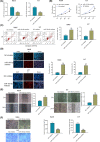MicroRNA-183-5p contributes to malignant progression through targeting PDCD4 in human hepatocellular carcinoma
- PMID: 33078826
- PMCID: PMC7601345
- DOI: 10.1042/BSR20201761
MicroRNA-183-5p contributes to malignant progression through targeting PDCD4 in human hepatocellular carcinoma
Abstract
Hepatocellular carcinoma (HCC) remains one of the most common malignant tumors worldwide. The present study aimed to investigate the biological role of microRNA-183-5p (miR-183-5p), a novel tumor-related microRNA (miRNA), in HCC and illuminate the possible molecular mechanisms. The expression patterns of miR-183-5p in clinical samples were characterized using qPCR analysis. Kaplan-Meier survival curve was applied to evaluate the correlation between miR-183-5p expression and overall survival of HCC patients. Effects of miR-183-5p knockdown on HCC cell proliferation, apoptosis, migration and invasion capabilities were determined via Cell Counting Kit-8 (CCK8) assays, flow cytometry, scratch wound healing assays and Transwell invasion assays, respectively. Mouse neoplasm transplantation models were established to assess the effects of miR-183-5p knockdown on tumor growth in vivo. Bioinformatics analysis, dual-luciferase reporter assays and rescue assays were performed for mechanistic researches. Results showed that miR-183-5p was highly expressed in tumorous tissues compared with adjacent normal tissues. Elevated miR-183-5p expression correlated with shorter overall survival of HCC patients. Moreover, miR-183-5p knockdown significantly suppressed proliferation, survival, migration and invasion of HCC cells compared with negative control treatment. Consistently, miR-183-5p knockdown restrained tumor growth in vivo. Furthermore, programmed cell death factor 4 (PDCD4) was identified as a direct target of miR-183-5p. Additionally, PDCD4 down-regulation was observed to abrogate the inhibitory effects of miR-183-5p knockdown on malignant phenotypes of HCC cells. Collectively, our data suggest that miR-183-5p may exert an oncogenic role in HCC through directly targeting PDCD4. The current study may offer some new insights into understanding the role of miR-183-5p in HCC.
Keywords: PDCD4; hepatocellular carcinoma; malignant progression; microRNA-183-5p; poor prognosis.
© 2020 The Author(s).
Conflict of interest statement
The authors declare that there are no competing interests associated with the manuscript.
Figures





References
-
- Ahodantin J., Bou-Nader M., Cordier C., Megret J., Soussan P., Desdouets C. et al. . (2019) Hepatitis B virus X protein promotes DNA damage propagation through disruption of liver polyploidization and enhances hepatocellular carcinoma initiation. Oncogene 38, 2645–2657 10.1038/s41388-018-0607-3 - DOI - PubMed
-
- Liu R., Li Y., Tian L., Shi H., Wang J., Liang Y. et al. . (2019) Gankyrin drives metabolic reprogramming to promote tumorigenesis, metastasis and drug resistance through activating beta-catenin/c-Myc signaling in human hepatocellular carcinoma. Cancer Lett. 443, 34–46 10.1016/j.canlet.2018.11.030 - DOI - PubMed
Publication types
MeSH terms
Substances
LinkOut - more resources
Full Text Sources
Medical

